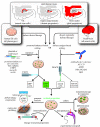Cell replacement therapy in neurological disease
- PMID: 16939969
- PMCID: PMC1664668
- DOI: 10.1098/rstb.2006.1886
Cell replacement therapy in neurological disease
Abstract
Diseases of the brain and spinal cord represent especially daunting challenges for cell-based strategies of repair, given the multiplicity of cell types within the adult central nervous system, and the precision with which they must interact in both space and time. Nonetheless, a number of diseases are especially appropriate for cell-based therapy, in particular those in which single phenotypes are lost, and in which the re-establishment of vectorially specific connections is not entirely requisite for therapeutic benefit. We review here a set of potential therapeutic indications that meet these criteria as potentially benefiting from the transplantation of neural stem and progenitor cells. These include: (i) transplantation of phenotypically restricted neuronal progenitor cells into diseases of a single neuronal phenotype, such as Parkinson's disease; (ii) implantation of mixed progenitor pools into diseases characterized by the loss of a limited number of discrete phenotypes, such as spinal cord injury and the motor neuronopathies; (iii) transplantation of glial and nominally oligodendrocytic progenitor cells as a means of treating disorders of myelin; and (iv) transplantation of neural stem cells as a means of treating lysosomal storage disorders and other diseases of enzymatic deficiency. Among the diseases potentially approachable by these strategies, the myelin disorders, including the paediatric leucodystrophies as well as adult traumatic and inflammatory demyelinations, may present the most compelling targets for cell-based neurological therapy.
Figures





Similar articles
-
Stem and progenitor cell-based therapy of the human central nervous system.Nat Biotechnol. 2005 Jul;23(7):862-71. doi: 10.1038/nbt1119. Nat Biotechnol. 2005. PMID: 16003375
-
Progenitor cell-based myelination as a model for cell-based therapy of the central nervous system.Ernst Schering Res Found Workshop. 2006;(60):195-213. doi: 10.1007/3-540-31437-7_13. Ernst Schering Res Found Workshop. 2006. PMID: 16903424 Review.
-
Stem cells and neurological diseases.Cell Prolif. 2008 Feb;41 Suppl 1(Suppl 1):94-114. doi: 10.1111/j.1365-2184.2008.00486.x. Cell Prolif. 2008. PMID: 18181951 Free PMC article. Review.
-
Cell therapy for central nervous system disorders: Current obstacles to progress.CNS Neurosci Ther. 2020 Jun;26(6):595-602. doi: 10.1111/cns.13247. Epub 2019 Oct 17. CNS Neurosci Ther. 2020. PMID: 31622035 Free PMC article. Review.
-
Enhancing CNS repair in neurological disease: challenges arising from neurodegeneration and rewiring of the network.CNS Drugs. 2011 Jul;25(7):555-73. doi: 10.2165/11587830-000000000-00000. CNS Drugs. 2011. PMID: 21699269 Free PMC article. Review.
Cited by
-
Recent advances in corneal regeneration and possible application of embryonic stem cell-derived corneal epithelial cells.Clin Ophthalmol. 2007 Dec;1(4):373-82. Clin Ophthalmol. 2007. PMID: 19668514 Free PMC article.
-
Paracrine Mechanisms of Intravenous Bone Marrow-Derived Mononuclear Stem Cells in Chronic Ischemic Stroke.Cerebrovasc Dis Extra. 2016;6(3):107-119. doi: 10.1159/000446404. Epub 2016 Oct 19. Cerebrovasc Dis Extra. 2016. PMID: 27846623 Free PMC article.
-
Therapeutic effects of stem cells in different body systems, a novel method that is yet to gain trust: A comprehensive review.Bosn J Basic Med Sci. 2021 Dec 1;21(6):672-701. doi: 10.17305/bjbms.2021.5508. Bosn J Basic Med Sci. 2021. PMID: 34255619 Free PMC article. Review.
-
Directed fiber outgrowth from transplanted embryonic cortex-derived neurospheres in the adult mouse brain.Neural Plast. 2009;2009:852492. doi: 10.1155/2009/852492. Epub 2010 Feb 14. Neural Plast. 2009. PMID: 20169102 Free PMC article.
-
Direct Reprogramming of Mouse Fibroblasts to Neural Stem Cells by Small Molecules.Stem Cells Int. 2016;2016:4304916. doi: 10.1155/2016/4304916. Epub 2015 Dec 16. Stem Cells Int. 2016. PMID: 26788068 Free PMC article.
References
-
- Arber S, Han B, Mendelsohn M, Smith M, Jessell T.M, Sockanathan S. Requirement for the homeobox gene Hb9 in the consolidation of motor neuron identity. Neuron. 1999;23:659–674. 10.1016/S0896-6273(01)80026-X - DOI - PubMed
-
- Back S, Rivkees S. Emerging concepts in periventricular white matter injury. Semin. Perinatol. 2004;6:405–414. 10.1053/j.semperi.2004.10.010 - DOI - PubMed
-
- Bjorklund A, Lindvall O. Cell replacement therapies for central nervous system disorders. Nat. Neurosci. 2000;3:537–544. 10.1038/75705 - DOI - PubMed
-
- Bjorklund L, Sanchez-Pernaute R, Chung S, Jenkins B, Wahlestedt C, Kim K.M, Isacson O. Embryonic stem cells develop into functional dopaminergic neurons after transplantation in a Parkinson rat model. Proc. Natl Acad. Sci. USA. 2002;99:2344–2349. 10.1073/pnas.022438099 - DOI - PMC - PubMed
-
- Brustle O, Choudhary K, Karram K, Huttner A, Murray K, Dubois-Dalcq M, McKay R. Chimeric brains generated by intraventricular transplantation of fetal human brain cells into embryonic rats. Nat. Biotechnol. 1998;16:1040–1044. - PubMed
Publication types
MeSH terms
LinkOut - more resources
Full Text Sources
Other Literature Sources

